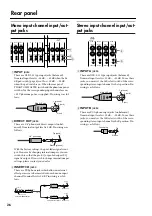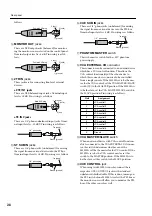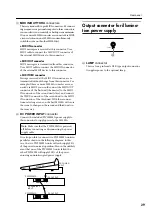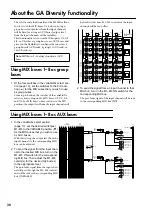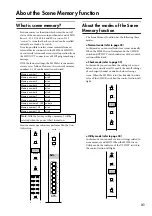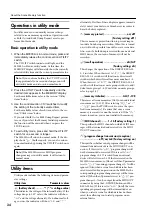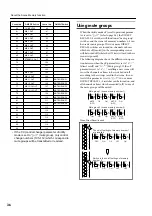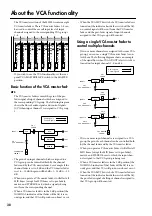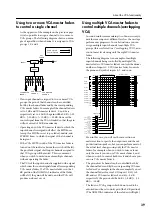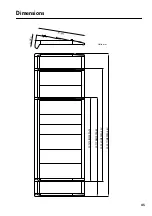
About the VCA functionality
39
Using two or more VCA master faders
to control a single channel
As the opposite of the example on the previous page,
it is also possible to assign a channel to two or more
VCA groups. The following diagram shows an exam-
ple of signal flow when channel 1 is assigned to VCA
groups 1, 5, and 8.
• If an input channel is assigned to two or more VCA
groups, the gain of that channel can be controlled
both by the channel fader and by the corresponding
VCA master faders. For example if the channel fader is
set to 0 dB and VCA master faders 1, 5, and 8 are
respectively set to -10 dB, the gain will be 0 dB + (–10
dB) + (–10 dB) + (–10 dB) = –30 dB. However the
control signal from the VCA is limited so that the gain
will not 20 dB at maximum.
• Operating any of the VCA master faders to which the
input channel is assigned will affect the MIX buses
(except for MIX buses set to pre-fader), matrix, and
STEREO buses to which the signal of that channel is
being sent.
• If the VCA MUTE switch of the VCA master fader is
turned on (the indicator beside the switch will be lit),
the post-fader signal of all input channels assigned to
that VCA group will be muted. This is convenient
when you wish to mute/un-mute multiple channels
without operating the fader.
• The VCA of the input channel is supplied with a signal
which sums the control signals from all corresponding
VCA master faders. If a VCA master fader is in the 0
dB position (the NOMINAL indicator of that fader
will be lit), the gain will be unity, and that VCA will
produce no boost or cut.
Using multiple VCA master faders to
control multiple channels (overlapping
VCA)
In sound reinforcement mixing it is often necessary to
mix the same inputs at different levels as the on-stage
performance progresses. In such situations, you can
assign multiple input channels to multiple VCA
groups (this is referred to as “overlapping VCA”), and
control most levels using only the eight VCA master
faders.
The following diagram is an example of multiple
input channels being controlled by multiple VCA
master faders; VCA master fader 1 controls the drums
and bass of inputs 1–3, VCA master fader 2 controls
the piano and synth of inputs 4–7, and so on.
Even in this case, you will use the mix section or
matrix section to specify the output mix and the out-
put destination speakers, but you can perform most of
the actual level changes using only the VCA master
faders; for example when you wish to raise or lower
only the vocals you can use VCA master fader 5, and
when you wish to control both vocals and chorus you
can use VCA master fader 6.
• The gain of each channel can be controlled both by
the channel fader and by the corresponding VCA mas-
ter faders. For example in the above example if you set
the channel faders for vocal 1/2 (inputs 10/11) to 0
dB, and set VCA master faders 5 and 6 to –5 dB
respectively, the gain would be 0 dB + (–5 dB) + (–5
dB) = –10 dB.
• The faders of VCA groups which do not need to be
adjusted must be set to unity gain (the 0 dB position).
(The NOMINAL indicator of these faders will light.)
INPUT 1
VCA MASTER
FADER 1
VCA MASTER
FADER 5
VCA MASTER
FADER 8
CH1
FADER
OUT
VCA
Adder
Audio signals
Control signals
1
2
3
4
5
6
7
8
9
10
11
12
1
2
3
4
5
6
7
8
13
14
15
16
Channel faders
VCA MASTER
faders
MIX master faders
M1–M16 controls
Drums
Bass
Piano
Guitar1
Vocal 1
Chorus1
Chorus2
Chorus3
Vocal 2
Guitar2
Synth
VCA GROUP switches
Control
drums and bass
Control
piano and synth
Control
all instruments
Control
chorus 1–3
Control
vocal 1 and 2
Control
vocal and chorus
Control
guitar 1 and 2
Control
other than vocal


